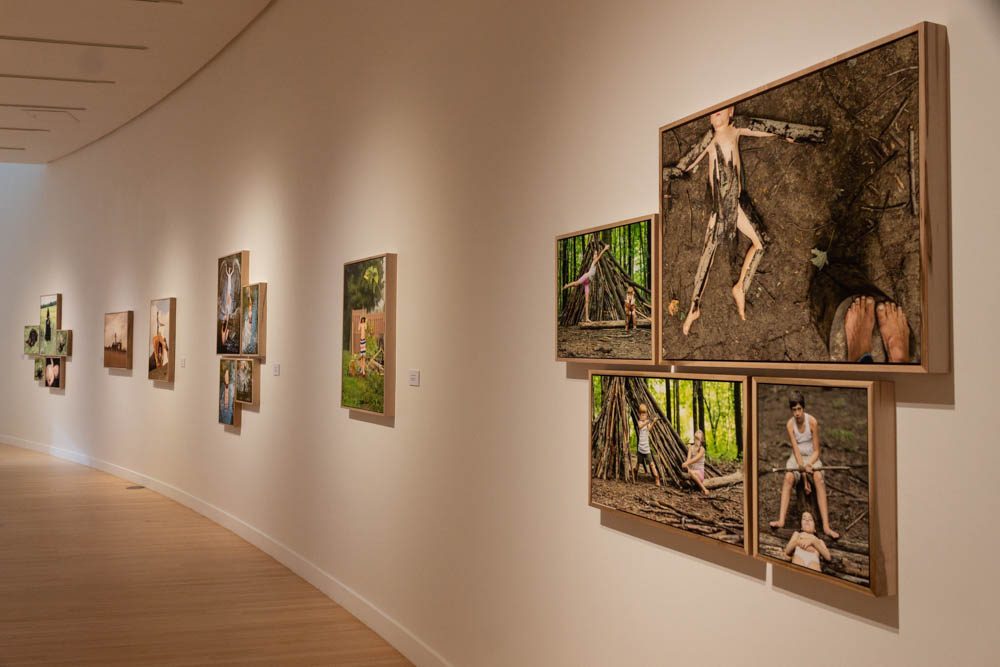
Holly Engel
A&E Editor
We have all dreamed of flying. Even now, as we work to meet deadlines and bustle through the business of life, childhood imaginings can still develop at the back of our minds, full of color. It is these imaginings that Bridget Milligan, the
department chair and an associate professor of art and art history at The College of Wooster, has presented in her photographic exhibition “Wonder Tales: The Imprint of Child’s Play.” The exhibit, which features several photos of Milligan’s children, opened with a reception and a gallery talk by Milligan this past Thursday, Jan. 23 at The College of Wooster Art Museum (CWAM). “There were a lot of people at the talk,” said Andrea Arts ’20. “It was a pretty full house.”
Arts said she was particularly fond of how the photography brought the imaginary worlds of the children in the photos to life. “They’re very striking photographs, and it’s always interesting to see photography on display as an artistic medium,” Arts said. Her favorite piece was “Dream Flight,” a photo of Milligan’s son at the top of a pole, wearing wings made of found objects. “There’s really a youthfulness and a playfulness in the photographs that take me back to moments in my childhood,” Arts added.
According to Milligan, the photos were taken over a four-year span. “I have been photographing for nearly two decades, and having my children really transformed the way that I thought about photography,” Milligan said. “I no longer saw light as a perception of image and reality, but instead as an energy, and as the image itself.”
Milligan grew curious about her children’s curiosity and imaginations, which is what prompted her own imagination. “The whole project started out as an exploration of play,” she remembered, “and my children became the actors and the players. We created a stage, and the stage just happened to be our backyard.” Her children worked with her to create the scenes on this “stage” and the objects within the scenes as well. “We would spend hours collecting [objects], and then we would use those objects as weapons or tools or balance beams, survival tools that would launch us into this creative space,” Milligan said.
This “exploration of play” also includes how play can be used to process the world. “In a time where children are so exposed to screens and technology, they are disconnected with real world experiences,” said Milligan. “Instead of interacting often with each other, children develop social skills through games like Fortnite or through watching YouTubers. There’s a complete disconnect there.” Milligan believes that imaginative play is what creates our needed connections. “Playing is fun to do, sure,” she said, “but it’s also important to our cognitive, physical and social wellbeing and development. It helps us understand who we are.”
The connection that play creates between children and the world can be seen clearly in Milligan’s piece “Bear Hug.” It is what Milligan calls an “image puzzle” comprised of photos linked by a single theme. In each photo, the children are interacting with a bear skin, and in the largest, central image, Milligan’s daughter holds the skin in front of her, her arms wrapped around it in a hug. “Children are naturally drawn to animals,” Milligan said. “The bearskin really allowed the children to become the bear and think about how their relationship is to that animal and to the natural environment.”
Generally, the photos are bright and vibrant, but one piece, “Fixed/Unfixed Childhood Drawings,” contrasts greatly. It is a collage of salted paper prints of the children’s drawings, some of which stand out clearly and others which have faded away. “80 percent of them will fade, will completely disintegrate into nothing but vestiges of the past,” Milligan explained. “It really speaks about the ephemeral quality in the idea of child’s play. While we can only preserve a small portion of childhood memories, much of that is still fabricated in our mind.”
In response to the artwork, Arts believes that the exhibit is meant for people of all ages and all backgrounds. “It’s certainly very fantastical and whimsical,” she said, “and I think there’s something really universal about this perspective on childhood, about this fantasy aspect of it.”
Likewise, Milligan hopes that the exhibit will inspire the child inside all of us. “Think about playing a bit more in order to reconnect to that inner child,” she says. “It can really spark a feeling of remembrance and recognition, reminding us that deep down inside, we are more alike than we are different.”
Milligan’s exhibit will be open from now until Thursday March 5 in the Sussel Gallery of CWAM. For more information, visit the museum’s webpage at wooster.edu.
